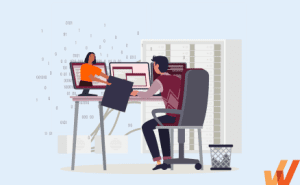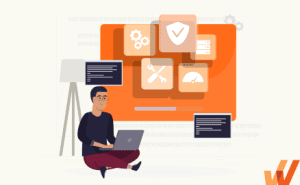The role of the Chief Information Officer (CIO) has evolved well beyond traditional IT management. CIOs are now strategic leaders responsible for driving digital transformation, optimizing technology investments, and enabling enterprise-wide innovation.
In 2025, the pace of change is accelerating, with Generative AI (GenAI), digital adoption, cybersecurity, and IT cost optimization reshaping how businesses operate. CIOs are expected to embed AI into enterprise applications, support employees in the flow of work, and streamline IT spending—all while ensuring seamless integration, security, and measurable ROI.
But with so many competing priorities, how do CIOs ensure they invest in the right technologies and maximize business impact?
This article explores the top 10 IT trends defining the CIO agenda in 2025, providing actionable strategies to help CIOs prioritize investments, drive digital adoption, and build a future-ready IT strategy.
10 IT Trends Facing CIOs in 2025
- Embracing GenAI for IT and business transformation
- Supporting end-users in the flow of work
- Maximizing software ROI
- Crafting a future-proof digital roadmap
- Leveraging sandbox training for software proficiency
- Strengthening cybersecurity and compliance
- Enhancing customer experience with digital solutions
- Standardizing enterprise platforms for operational efficiency
- Adopting AI and emerging tech without the hype
- Building a digital workplace that works
1. Embracing GenAI for IT and Business Transformation
For years, artificial intelligence (AI) has played a supporting role in enterprise IT—powering automation, analytics, and customer service functions. But 2025 marks a turning point. GenAI has moved from an experimental technology to a business-critical tool, forcing CIOs to rethink how they integrate AI into enterprise workflows, enhance decision-making, and create business value.
Organizations that successfully implement GenAI are seeing measurable efficiency gains—from automating IT support and accelerating software development to enhancing enterprise search and data insights.
Yet, scaling AI adoption comes with challenges: data security risks, compliance concerns, and the need to upskill employees to manage AI-driven workflows.
How GenAI is reshaping enterprise IT
GenAI’s impact extends across multiple areas of IT and business operations:
- IT automation and support: AI-powered service desks and chatbots reduce response times, resolve user issues faster, and free up IT teams for higher-value work.
- Software development: AI-assisted coding tools help developers build, test, and deploy applications more efficiently, shortening development cycles.
- Data analysis and insights: GenAI accelerates business intelligence by summarizing datasets, generating reports, and automating forecasting—enabling faster, more informed decision-making.
- Enterprise search and knowledge management: AI-enhanced search capabilities help employees find critical information faster, boosting productivity across departments.
Despite its potential, AI adoption at scale isn’t plug-and-play. CIOs must take a strategic, people-first approach to ensure AI delivers real business value rather than becoming another underutilized investment.
How CIOs can Successfully Adopt Generative AI
To integrate GenAI effectively, CIOs should:
- Align AI investments with business priorities: Identifying high-impact use cases that directly improve revenue, operational efficiency, or customer experience.
- Implement responsible AI governance: Establish transparency and compliance frameworks to address data security, ethical AI use, and regulatory risks.
- Upskill employees for an AI-powered workforce: Provide on-demand training and in-app guidance to help teams confidently adopt and use AI tools.
Whatfix AI: Powering People-Led AI Adoption
AI’s success depends on adoption—that’s where Whatfix transforms how enterprises implement and scale AI-powered tools, including:
- Simplifies AI-driven workflows: Whatfix AI Assistant enables employees to interact with enterprise applications using natural language commands, making AI-powered tools intuitive and accessible.
- Enhances employee productivity with AI-powered content generation: With its in-app personal scribe, Whatfix AI helps users draft emails, take notes, and generate content directly within enterprise applications.
- Ensures responsible AI use: Whatfix AI is built with strict security measures, keeping data private while ensuring organizations maintain complete control over their AI models.
With a clear strategy and a strong digital adoption framework, CIOs can harness the full power of GenAI, transforming how IT teams operate, employees work, and businesses grow. You can explore Whatfix for AI Adoption to learn more about how to take a people-first approach to AI value realization.
2. Supporting End-Users in the Flow of Work
Technology adoption is no longer just an IT challenge—it’s a business imperative. Enterprises invest millions in software, but employees struggle to use new tools effectively without effective onboarding and continuous support. The result: low adoption rates, lost productivity, and increased IT support costs.
Traditional training methods—lengthy documentation, classroom-style sessions, and one-time onboarding—no longer work given the rapid evolution of technology. Employees want (and need) to learn in real time—within the applications they use daily—without interrupting their flow of work.
Why Traditional Training Falls Short
CIOs face a critical challenge: How do you train and support a workforce constantly navigating new software and evolving workflows?
Some of the most prominent issues include:
- Scalability issues: Training programs must reach thousands of employees across departments and geo-locations.
- Low retention rates: Employees forget up to 70% of what they learn within 24 hours of a traditional training session and even more by the end of the week, a phenomenon known as the Forgetting Curve.
- High IT support costs: Repetitive IT tickets for password resets, navigation issues, and basic software functions overwhelm IT teams.
This is where in-app guidance and real-time support set a new standard for enterprise learning. Instead of expecting employees to pause work to learn, organizations must bring learning into the work flow.
How CIOs Can Support End-Users More Effectively
To bridge the gap between training and real-world application, CIOs should:
- Adopt a digital adoption strategy: Move beyond traditional LMS (Learning Management System) platforms and leverage in-app guidance, self-service support, and contextual learning tools.
- Enable employees with real-time assistance: Provide on-demand help directly within applications so users don’t have to leave their workflows to seek answers.
- Use data to improve training: Track how employees interact with software and identify areas where they struggle—for targeted, data-driven interventions.
Whatfix: Transforming User Support in the Flow of Work
Whatfix helps CIOs eliminate software adoption barriers by embedding real-time guidance, automation, and analytics into enterprise applications.
- Interactive walkthroughs and product tours: Guide users step-by-step through complex workflows with product tours and guided walkthroughs.
- Self-service knowledge hub: Provide employees with on-demand access to FAQs, video tutorials, and process documentation—directly inside the application.
- Task lists: Deliver personalized training checklists that track progress and ensure employees complete critical workflows efficiently.
- Sandbox application environments: Allow employees to practice new workflows and software functionalities in a risk-free environment, improving confidence and reducing errors in live systems.
- Actionable analytics: Monitor user behavior and software engagement metrics (with Whatfix Analytics) to pinpoint adoption challenges and optimize training methods.
By integrating learning into everyday tasks, Whatfix empowers organizations to reduce training time, improve productivity, and lower IT support costs—helping CIOs maximize the RIO of their digital transformation efforts.
3. Maximizing Software ROI
Enterprise IT budgets are under constant scrutiny. CIOs are expected to modernize technology stacks, optimize costs, and deliver measurable business value, but software investments often fail to provide true ROI due to low adoption, redundant tools, and inefficient usage.
Recent studies indicate that enterprises waste a significant portion of their SaaS expenditures due to underutilization. According to Zylo’s 2023 SaaS Management Index report, 44% of SaaS licenses go unused, leading to approximately $17 million in wasted spend annually.
This level of inefficiency stems from low user adoption, poor governance, and decentralized software purchasing decisions. Without proper oversight and adoption strategies, software investments become costly inefficiencies rather than productivity drivers.
Why Maximizing Software ROI is a CIO Priority
A misaligned SaaS and IT strategy can create:
- Underultized subscriptions: Tools are purchased but remain unused due to poor onboarding and lack of user training.
- SaaS redundancy: Departments independently procure software, resulting in multiple tools performing the same function.
- Resistance to change: Employees stick to legacy processes, failing to adopt new tools effectively.
- Uncontrolled IT spend: Without tracking software usage, companies overspend on unused or duplicate applications.
How CIOs Can Maximize Software ROI
To ensure technology investments drive business impact, CIOs should:
- Conduct regular SaaS audits: Identify unused, redundant, or underutilized software licenses and streamline subscriptions.
- Drive digital adoption: Deploy in-app guidance to ensure employees fully leverage software capabilities.
- Use data to optimize IT spend: Track real-time adoption metrics and adjust licensing based on usage patterns.
- Create IT governance policies: Establish approval workflows for SaaS purchases to prevent duplicate tool acquisition.
Whatfix: Unlocking Full Software ROI
CIOs need more than cost-cutting measures—they must ensure employees use the tools they pay for. Whatfix provides a data-driven, people-first approach to software optimization:
- In-app guidance for seamless adoption: Helps employees navigate enterprise software effortlessly, reducing friction and ensuring full utilization.
- SaaS usage analytics: Tracks how employees interact with software, identifying underused applications and areas needing additional training.
- User engagement optimization: Uses personalized walkthroughs, tooltips, and pop-ups to encourage feature adoption and prevent shelfware.
- Streamlined onboarding and change management: Ensures new SaaS implementations are successful, reducing resistance and accelerating time to value.
By integrating Whatfix’s digital adoption platform (DAP), CIOs can reduce SaaS waste, improve employee productivity, and maximize software ROI without increasing IT overhead.
4. Crafting a Future-Proof Digital Roadmap
Modern CIOs are navigating an IT landscape in constant flux, balancing legacy systems, emerging technologies, cybersecurity risks, and shifting business priorities. The challenge isn’t just adopting new technologies—it’s building a digital roadmap that ensures long-term agility, scalability, and business impact.
Yet, many enterprises fall into the trap of chasing the next “shiny object.” Exciting innovations—like AI, blockchain, and automation—capture attention, but without a structured roadmap, IT investments can become disjointed, expensive experiments rather than strategic enablers.
Why CIOs Need a Structured Digital Roadmap
Without a clear strategy, enterprises face:
- Scattered IT investments: Multiple departments independently invest in overlapping technologies without alignment with organization-wide goals.
- Disruptive IT silos: Legacy systems and new digital tools fail to integrate, causing inefficiencies and fragmented user experiences.
- Budget drain from experimentation: Lack of governance around IT innovation leads to excessive spending on unproven technologies.
- Slow adoption of new tools: Employees struggle with change, resulting in low utilization of newly deployed systems.
How CIOs Can Build a Resilient Digital Roadmap
To ensure IT initiatives deliver long-term value, CIOs should:
- Align IT strategy with business objectives: Every tech initiative should map directly to business priorities, customer needs, or operational efficiency gains.
- Balance core IT requirements and innovation: Maintain a separate budget for essential IT infrastructure versus experimental technologies.
- Standardize and integrate systems: Avoid SaaS sprawl by consolidating overlapping applications and ensuring seamless platform integration.
- Adopt a continuous improvement approach: Treat the digital roadmap as a living document, adjusting strategies based on live performance data.
Whatfix: Driving Digital Adoption in Your IT Roadmap
A successful IT roadmap isn’t just about choosing the right tools—it’s about ensuring those tools are adopted and delivering value. Whatfix bridges the gap between IT strategy and execution by helping CIOs:
- Accelerate new technology adoption: Reduce resistance to change with step-by-step in-app guidance, automated workflows, and interactive training.
- Standardize digital transformation: Ensure consistent user experiences across enterprise applications, preventing silos.
- Optimize IT investments with analytics: Use real-time engagement data to measure which applications employees actively use and where they need support.
- Enable scalable change management: Roll out new IT systems efficiently, with contextual user support and personalized onboarding journeys.
By embedding the Whatfix DAP into their digital transformation strategy, CIOs can ensure that technology investments translate into tangible business outcomes, driving innovation, productivity, and sustained IT success.
5. Leveraging Sandbox Training for Software Proficiency
Employee proficiency with enterprise software is critical to operational success—yet traditional training methods often fail to prepare users for real-world workflows.
Lengthy manuals, video tutorials, and classroom-style sessions don’t replicate actual software usage, leaving employees unprepared and reliant on IT support when they face challenges.
CIOs must prioritize hands-on, risk-free training environments that allow employees to learn by doing—without disrupting live systems or risking errors in production environments. This is where sandbox training sets a new standard for training.
Why Sandbox Training is Imperative for Enterprises
Without a realistic practice environment, organizations face:
- Slow employee ramp-up: New hires and employees transitioning to new software struggle with onboarding, delaying productivity.
- High error rates: Employees learn by trial and error in live systems, increasing risks of data loss, compliance issues, and costly mistakes.
- IT and help desk overload: Training gaps result in repetitive IT support requests, consuming valuable resources and time.
- Low feature adoption: Employees avoid using complex software features, leading to underutilized tools and wasted SaaS spend.
How CIOs Can Implement Effective Sandbox Training
To equip employees with practical skills while minimizing risks, CIOs should:
- Deploy virtual sandbox environments: Enable employees to train in interactive, risk-free software environments that mirror the actual application.
- Make training contextual and self-paced: Allow employees to practice workflows as needed rather than relying on rigid, one-time training sessions.
- Ensure training updates in real time: Traditional training quickly becomes outdated—sandbox environments should automatically reflect changes in the live system.
- Track and improve training effectiveness: Use analytics to monitor user engagement and refine training programs based on real-time insights.
Whatfix Mirror: The Future of Interactive Software Training
Whatfix redefines enterprise training with Whatfix Mirror, an immersive, hands-on training solution that helps employees master software workflows without disrupting production systems.
- Interactive training without risks: Whatfix Mirror creates a virtual environment where users can practice workflows without affecting production data or systems.
- Automatic updates for real-world relevance: Unlike static training modules, Mirror updates training instances in real time, ensuring employees always work on the latest software version.
- Seamless integration with LMS and self-help systems: Organizations can embed sandbox training within existing learning management systems or provide it on-demand as a self-service resource.
- Faster employee proficiency and reduced IT burden: Employees gain confidence and efficiency, reducing errors, IT support requests, and productivity loss.
By leveraging Whatfix Mirror, CIOs can transform software training from a passive learning experience into an active, hands-on process—ensuring employees are not just trained, but are fully proficient.
6. Strengthening Cybersecurity and Compliance
With cyber threats emerging at an unprecedented pace, CIOs are under immense pressure to protect enterprise data, maintain compliance, and prevent costly breaches—all while ensuring security measures don’t disrupt business operations.
The stakes have never been higher. A single ransomware attack or data breach can result in millions of dollars in financial losses, not to mention regulatory penalties and reputational damage. Yet, many enterprises remain vulnerable. A 2022 ISACA report found that 62% of organizations report their cybersecurity teams are understaffed, while 60% struggle to retain qualified security talent.
As businesses expand their digital footprints with cloud services, AI, and remote work infrastructure, CIOs must adopt a proactive, user-centric approach to cybersecurity and compliance.
Why Cybersecurity and Compliance are CIO Priorities
Cyber threats are no longer just an IT issue—they are a business continuity risk with key challenges including:
- Rising threats from ransomware and social engineering: Phishing, credential stuffing, and AI-powered cyberattacks are becoming increasingly sophisticated.
- Regulatory complexity: Enterprises must comply with GDPR, CCPA, HIPAA, and other evolving data protection laws, and failure to do so can result in hefty fines.
- Security talent shortage: Organizations struggle to hire and retain skilled cybersecurity professionals, increasing exposure to vulnerabilities.
- User-induced risk: Employees inadvertently expose enterprises to security risks due to a lack of awareness or improper handling of sensitive data.
How CIOs Can Strengthen Enterprise Cybersecurity
To mitigate threats and maintain compliance, CIOs should:
- Adopt a zero-trust security model: Implement least-privilege access, continuous authentication, and network segmentation to minimize attack surfaces.
- Automate compliance monitoring: Use AI-powered tools to track regulatory changes, enforce policies, and flag potential violations in real time.
- Prioritize cybersecurity training: Equip employees with interactive, in-the-flow security awareness training to prevent phishing and human error breaches.
- Embed security into business workflows: Ensure security protocols integrate seamlessly with day-to-day operations, avoiding unnecessary friction.
Whatfix: Enabling Security-First Digital Adoption
A strong cybersecurity framework is only as effective as the people using it. Whatfix helps organizations enforce security policies, educate employees, and drive compliance through in-app, real-time guidance.
- Interactive cybersecurity training: Provide step-by-step security awareness training directly within applications, reducing reliance on external modules.
- Automated policy acknowledgments with task list nudges: Ensure users acknowledge security policies before accessing critical systems by prompting them to complete security-related tasks.
- Compliance tracking and analytics: Monitor user engagement with security policies to identify potential risks and enforce corrective actions.
By integrating Whatfix’s DAP, CIOs can embed security best practices into daily workflows, ensuring employees comply with security policies and actively reinforce them.
7. Enhancing Customer Experience with Digital Solutions
In 2025, customer experience (CX) can no longer be just a marketing or service concern—it must be a core IT priority. As digital interactions become the primary way customers engage with brands, CIOs are asked to lead the charge in creating seamless, intuitive, and responsive digital experiences.
Yet despite the urgency, CX initiatives often stall. In many organizations, CX operates in a silo—separate from IT infrastructure, disconnected from product data, and under-resourced when it comes to integration and support. CIOs must navigate these silos and build unified strategies that align technology with customer needs.
Why CX is a Strategic Focus for CIOs
According to Foundry’s State of the CIO survey, 57% of IT leaders cite improving customer experience as a top priority, and 81% are deploying new technologies to support customer interactions. However, several barriers persist, including:
- Departmental fragmentation: CX, marketing, product, and IT teams often operate independently, resulting in inconsistent experiences.
- Data disconnection: CIOs lack access to real-time usage data and customer insights that could improve digital journeys.
- Ineffective rollouts: New customer-facing technologies are often launched without adequate onboarding, training, or support, leading to poor adoption.
How CIOs Can Elevate the Digital Customer Experience
To ensure CX initiatives drive measurable value, CIOs should:
- Build cross-functional teams: Integrate CX, product, marketing, and IT teams to align priorities, resources, and digital touchpoints.
- Leverage product analytics: Use behavioral data to understand how customers interact with applications and identify friction points.
- Implement feedback loops: Use in-app surveys and Net Promoter Score (NPS) tools to capture customer sentiment and satisfaction. Then, feed those insights into product roadmaps to enhance digital experiences and drive continuous CX improvement.
- Support customers in real time: Deliver just-in-time guidance and contextual support within digital products to reduce frustration and increase customer satisfaction.
Whatfix: Empowering Seamless CX Across Digital Touchpoints
Whatfix helps CIOs deliver frictionless, personalized customer experiences by embedding digital guidance, analytics, and self-service tools into every interaction.
- In-app walkthroughs: Guide customers through onboarding, new features, or support workflows without ever leaving the application.
- Behavioral analytics: Track user journeys, feature adoption, and drop-off points to optimize product flows and eliminate friction.
- Real-time surveys and feedback collection: Capture user sentiment and NPS feedback directly within applications to measure satisfaction and inform CX improvements.
- Self-help widgets and knowledge base access: Allow customers to resolve issues independently, reducing reliance on support teams and increasing satisfaction.
By integrating Whatfix into customer-facing platforms, CIOs can transform static digital experiences into dynamic, personalized journeys—boosting engagement, satisfaction, and loyalty.
8. Standardizing Enterprise Platforms for Operational Efficiency
As enterprises expand—through growth, global operations, or mergers and acquisitions—their tech stacks often grow in parallel but not always in sync. Over time, this leads to siloed departments, redundant systems, inconsistent workflows, and fragmented data infrastructures that hinder organization-wide performance.
According to a 2023 report by Zylo, large organizations deploy an average of 660 SaaS applications, many of which overlap in functionality or are managed in isolation by regional or departmental teams. This lack of platform standardization creates complexity that slows down decision-making, reduces cross-functional efficiency, and complicates compliance.
Why Standardization Matters in 2025
CIOs face mounting pressure to streamline their tech ecosystems to reduce costs and drive operational agility and enterprise-wide cohesion. The risks of fragmented platforms include:
- Inefficient workflows: Teams rely on different tools for the same tasks, increasing training needs and decreasing process consistency.
- Data silos: Disparate systems store isolated data, preventing unified insights and slowing decision-making.
- Governance gaps: Inconsistent security, compliance, and usage policies across regions or departments create operational risk.
- Change management challenges: Without a unified digital infrastructure, enterprise-wide transitions become disruptive and resource-intensive.
How CIOs Can Drive Platform Unification
To simplify operations and scale efficiently, CIOs should focus on creating a harmonized application landscape:
- Map the ecosystem: Conduct a comprehensive audit to identify duplicate platforms, disconnected systems, and regional redundancies.
- Establish a platform governance model: Define central ownership, approval workflows, and rollout plans to manage enterprise systems holistically.
- Standardize core workflows: Choose organization-wide platforms for core functions (CRM, HCM, and ERP) and ensure consistent process execution across geographies.
- Prioritize user alignment: Deliver tailored enablement strategies to ensure employees transition smoothly to new, standardized platforms.
Whatfix: Powering Operational Consistency Across Enterprise Platforms
Whatfix enables CIOs to unify and standardize user experiences during large-scale platform migrations—without disrupting productivity.
- Smart tips for microlearning: Help users navigate standardized workflows across regions or departments with real-time, contextual guidance.
- Task lists for platform migration: Provide clear onboarding milestones to ensure users complete key setup and training steps during transitions.
- Performance support with self-help: Embed always-available help widgets that provide immediate access to FAQs, process documentation, and training content.
- User insights and analytics: Monitor behavioral patterns and workflow engagement to spot friction points, optimize rollout strategies, and improve process adoption.
- In-app segmentation and personalization: Tailor onboarding content by geography, role, or business unit to ensure relevance within a unified framework.
By embedding Whatfix into their platform consolidation strategy, CIOs can create a consistent, scalable digital foundation that accelerates collaboration, governance, and enterprise performance.
9. Adopting AI and Emerging Tech Without the Hype
Emerging technologies like GenAI, machine learning, and automation platforms are no longer futuristic buzzwords—they’ve become boardroom mandates. With the explosive growth of tools like ChatGPT, Microsoft CoPilot, Gemini, and Einstein GPT, CIOs are under growing pressure to deploy AI at scale—while simultaneously proving these investments translate into real, measurable business value.
But in the rush to “go AI,” many enterprises are overwhelmed by the complexity, internal friction, and inflated expectations. A 2024 study by Boston Consulting Group revealed that 74% of companies struggle to achieve and scale value from their AI initiatives despite significant investment.
Meanwhile, the 2025 Writer Generative AI Survey, which surveyed 800 C-suite executives and 800 employees, found that two-thirds of executives report AI adoption is causing tension and division, and 42% believe it’s tearing their organizations apart. 71% of executives cite adoption as their most significant barrier to becoming AI-first, and nearly half of employees report having to figure out AI tools on their own.
These findings point to a critical truth: technology alone doesn’t drive transformation. Adoption does. In 2025, CIOs must evolve into strategic enablers, ensuring AI and other emerging technologies are deployed with purpose, thoughtfully integrated, and scaled in ways that support employee readiness and organizational alignment.
How CIOs Can Lead AI and Emerging Tech Adoption with Intent
To ensure AI and emerging technologies deliver sustainable business impact, CIOs must balance innovation with intentional execution:
- Start with business-aligned use cases: Prioritize AI initiatives that solve real operational challenges or unlock clear efficiencies rather than deploying tech for tech’s sake.
- Deploy internally first: Use AI to streamline internal workflows—from IT service desks to reporting—to demonstrate value before expanding to customer-facing functions.
- Upskill employees for an ai-driven future: Provide ongoing, role-specific training that demystifies AI and builds digital dexterity across teams.
- Track adoption metrics, not just rollouts: Measure how, where, and how often AI tools are used to inform support strategies and future investments.
- Foster cross-functional ownership: Align IT, HR, and business leaders to co-own adoption strategies and prevent AI rollouts from becoming siloed or misaligned.
Whatfix: Turning Emerging Tech Into Everyday Capability
Whafix empowers CIOs to close the gap between AI ambition and workforce adoption by embedding digital enablement directly into the tools employees use:
- Beacon-Triggered Content for Feature Discoverability: Highlight new AI tools or copilots only when users are ready—helping teams discover functionality without overwhelming them.
- Field Validation and Smart Context Detection: Prevent data errors and friction by offering real-time tips as users interact with new AI-driven interfaces.
- Sentiment Collection with In-App Surveys: Capture real-time feedback on AI feature adoption to surface confusion, identify champions, and improve support strategies.
- Mirror for Safe AI Tool Exploration: Use Whatfix Mirror to create interactive training environments where employees can learn new AI tools in a risk-free environment—before touching live systems.
- Behavior-Driven Segmentation and Personalization: Tailor onboarding experiences based on user behavior, adoption stage, or job role to ensure relevance and retention.
- Conditional Flows for AI Use Cases: Deliver contextual walkthroughs only when users engage with AI features, ensuring support is timely, relevant, and non-intrusive.
With Whatfix, CIOs can ensure AI adoption is not just initiated—but embraced, scaled, and sustained across the enterprise.
10. Building a Digital Workplace That Works—Not Just Exists
In a hybrid-first, AI-enabled world, the term “digital workplace” has outgrown its buzzword status. For CIOs in 2025, it’s a mandate to build a cohesive, scalable, and intelligent digital environment where employees can access tools, share knowledge, and get work done—without disruption or digital fatigue.
Despite broad recognition of the digital workplace’s strategic value, many organizations still struggle to translate vision into reality. Too often, initiatives stall due to fragmented toolsets, lack of adoption, and poor alignment with how employees work. Without a unified approach that balances technology, usability, and employee empowerment, digital workplace efforts risk becoming disconnected deployments instead of transformational enablers.
A successful digital workplace isn’t defined by the number of tools in your stack—but how well they empower your employees to work smarter, not harder.
How CIOs Can Build a High-Impact Digital Workplace
To create a digital workplace that delivers measurable business value, CIOs should:
- Tie digital workplace KPIs to business outcomes: Define success in digital transformation KPIs based on productivity, collaboration, and retention metrics, not just tool deployment.
- Ensure seamless access across devices and locations: Eliminate friction with SSO, mobile-friendly platforms, and unified application ecosystems.
- Design for in-flow learning and support: Enable employees to solve problems and learn “in the moment” without switching context or breaking focus.
- Drive change management at scale: Pair new technology rollouts with role-based onboarding, ongoing enablement, and a clear communication strategy.
- Promote self-reliance through personalization: Tailor the digital experience to the unique needs of teams, regions, or roles to reduce support tickets and improve adoption.
Whatfix: Making the Digital Workplace Work for Everyone
Whatfix helps CIOs deliver frictionless, personalized, and self-sustaining digital workplaces by embedding intelligent support and guidance directly into everyday tools.
- Multi-Platform Enablement: Deliver a consistent onboarding and support experience across all digital surfaces—web, desktop, and mobile.
- QuickRead for Conversational, In-the-Flow Help: Provide AI-powered, summarized answers to user search queries—embedded directly within the application interface.
- Self-Help with Search-First Experience: Give employees instant access to FAQs, videos, and documentation via a persistent help widget powered by intuitive search.
- Whatfix Mirror for Workflow Training and Simulation: Allow employees to practice new tools and workflows in a risk-free training environment that mirrors real systems.
- Workplace Experience Analytics: Monitor how employees interact with tools and support content to identify friction points and optimize digital experiences over time.
With Whatfix, the digital workplace becomes more than just a place to work—it becomes a place where work flows.
Digital Strategies Clicks Better with Whatfix
CIOs today aren’t just steering IT strategy—they’re navigating a complex landscape of generative AI, cybersecurity threats, software ROI, employee enablement, and ever-rising expectations from customers and leadership. Success hinges on more than simply choosing the right technologies; it depends on empowering your workforce to fully embrace and leverage those technologies in their everyday workflows.
The modern CIO agenda in 2025 goes beyond tech selection—it requires thoughtful, human-centered implementation strategies, detailed analytics to measure real adoption, and a clear-eyed focus on ensuring every digital investment ties directly to business goals. This is exactly what Whatfix was built to achieve—turning high-level strategies into tangible, employee-driven outcomes, simplifying the complexity of digital adoption, and accelerating time-to-value across your enterprise tech stack.
Whether you’re embedding GenAI into daily workflows, streamlining software usage, fortifying cybersecurity, or building a frictionless digital workplace, Whatfix helps you overcome barriers to adoption and ensures your initiatives deliver real-world impact, not just potential.
Transform your digital ambitions into measurable results—partner with Whatfix to create an IT strategy that clicks.






